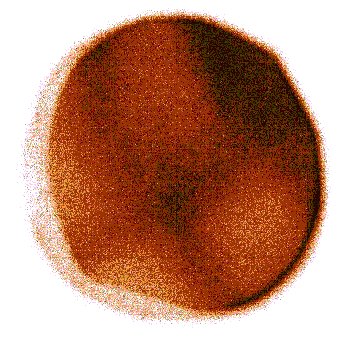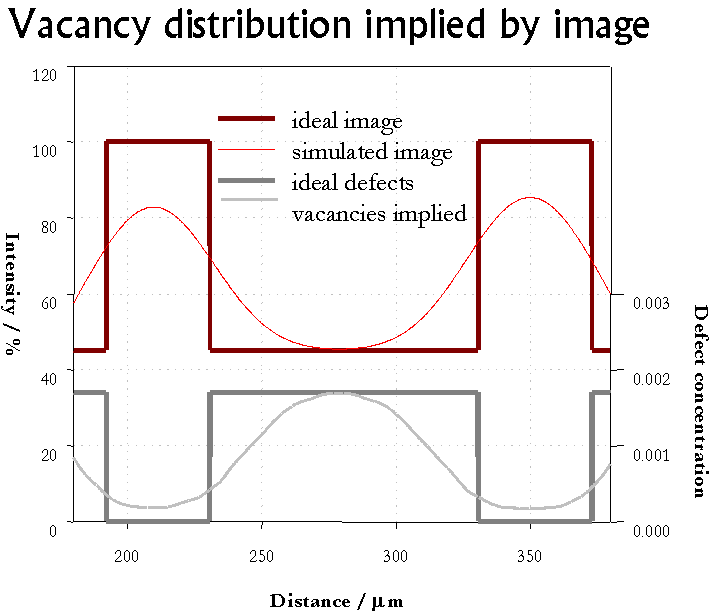
Introduction
Positron re-emission microscopy provides a very sensitive way of imaging near-surface vacancy-type defects in materials that re-emit positrons. In this study an images have been recorded of two 6H-SiC surfaces implanted with 50keV O+ ions through masks at different fluences prepared at the University of Surrey Centre for Ion Beam Applications.
SiC was chosen for two reasons: (a) it is known to re-emit low-energy positrons with high efficiency without the need for surface cleaning or annealing, and (b) there has been some discussion as to whether the positrons re-emitted from SiC are truly thermalized, or whether the high band-gap of ~ 3 eV prevents significant thermalization.
Positron microscopy offers a new look at the question of re-emission from SiC because epithermal positrons are not expected to form good quality images; additionally, the contrast seen between implanted and unimplanted regions can be compared with that predicted by simulations of thermal positron trapping at vacancy-type defects.
Furthermore the image produced provides the first chance to measure diffusion of these vacancy type defects in the plane of the surface. Previous studies of defected SiC using positron annihilation spectroscopy can only yield depth information on vacancy concentration.
Results
Positron image of SiC with spatially variable vacancies. Magnification » 80x on detector

The image above is of a SiC sample implanted at a high fluence to create a high density of vacancies. The high collection rate indicates efficient positron re-emission from the SiC, in contrast to epithermal emitters such as Si, which typically give signal rates an order of magnitude lower than this. Denser lines can clearly be seen in the image, corresponding to the areas shielded behind the mask.
The lower fluence sample yielded an image with much less contrast, but sharper resolution than the one shown.
The emission ratio for the lower fluence sample is 78(3)%. This ratio corresponds to a vacancy concentration of 2.0(5)´ 10-4 per atom, which is only 9(2)% of a value suggested by a simulation of implantation damage, TRIM.
The figure of 45(3)% seen with the high fluence SiC sample corresponds to a vacancy-type defect concentration of 1.6(3)´ 10-3 per atom (7(1)% of TRIM’s value). These results suggest that 92(2)% of vacancies produced below the surface during implantation of the O+ ions migrate to sinks or coalesce into divacancies.
The sharpness of the image from the lower fluence sample is a good indication that the positrons seen are predominantly emitted by the negative work function of SiC. The smearing associated with epithermal positron ‘images’ would make them uninterpretable in the present system.
The extra blurring in the high fluence sample was not merely due to less accurately set focusing voltages. This was confirmed by reference to an image of a sample known to have sharp features imaged immediately after the high fluence sample.
Implications
As epithermal positron emission can be ruled out as the reason for this smearing, movement of vacancies is implied. This is shown below

The vacancies in the masked areas imply a diffusion of vacancies over much greater distance than has been seen in previous studies. These measure vacancies against depth using differing energies to implant positrons to varying depths and analysing the Doppler broadening of their annihilation energy. One study compares their depth profile to that predicted by TRIM90, which show vacancies to a depth of 750 nm and 150-200 nm respectively, implying migration well under 1 mm. Our results imply a 44(5) mm F.W.H.M. migration of vacancies.
Although the lower point spread function in the low fluence sample is not consistent with vacancy mobility of the order of the high fluence sample, a shorter migration of vacancies would be consistent, as the microscope is capable of finer resolution than that seen in this image.
Conclusions
The data collection rate and sharpness of the images of the SiC sample in this experiment provide evidence that positron re-emission from SiC is via thermalization and subsequent work-function ejection. This conclusion is substantiated by the observation of trapping by vacancy-type defects created below the surface of the sample by ion implantation with a probability in line with that expected of thermalized positrons. Comparison with TRIM calculations suggests that 92(2)% of vacancies formed by the implanted ions recombine, migrate to sinks, or coalesce into larger open-volume defects (likely to be predominantly divacancies). The increased point spread function in the high fluence sample compared to the reference sample implies that there has been lateral movement of vacancies characterised by a broadening function with F.W.H.M. of 44(5) mm. This is of two orders of magnitude greater than any depth migration seen in previous positron annihilation spectroscopy studies.
The authors are indebted to Dr A P Knights for performing the O+ implantation at the University of Surrey Ion Beam Centre.